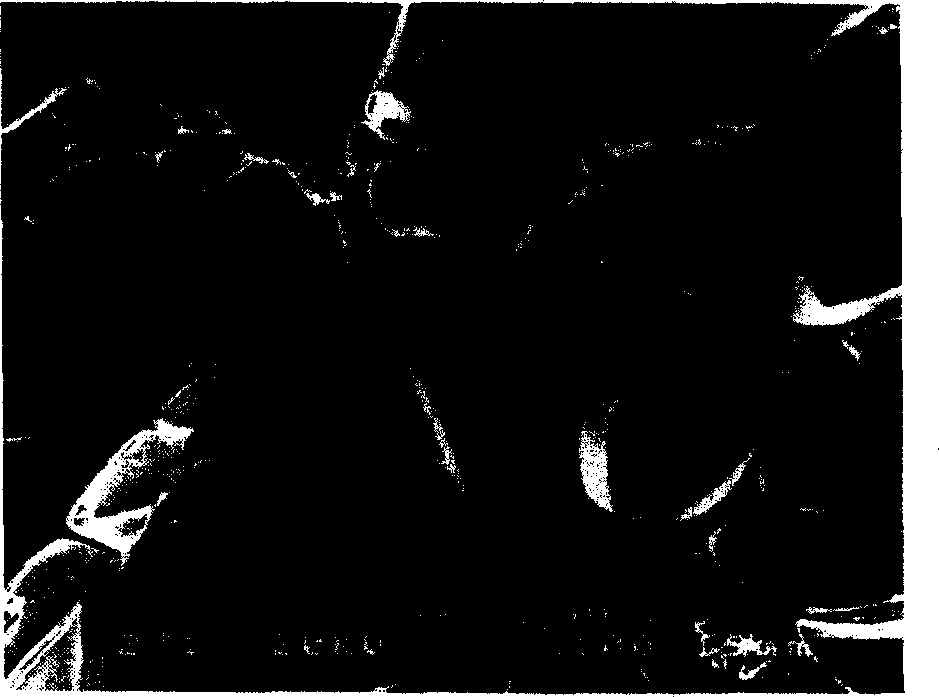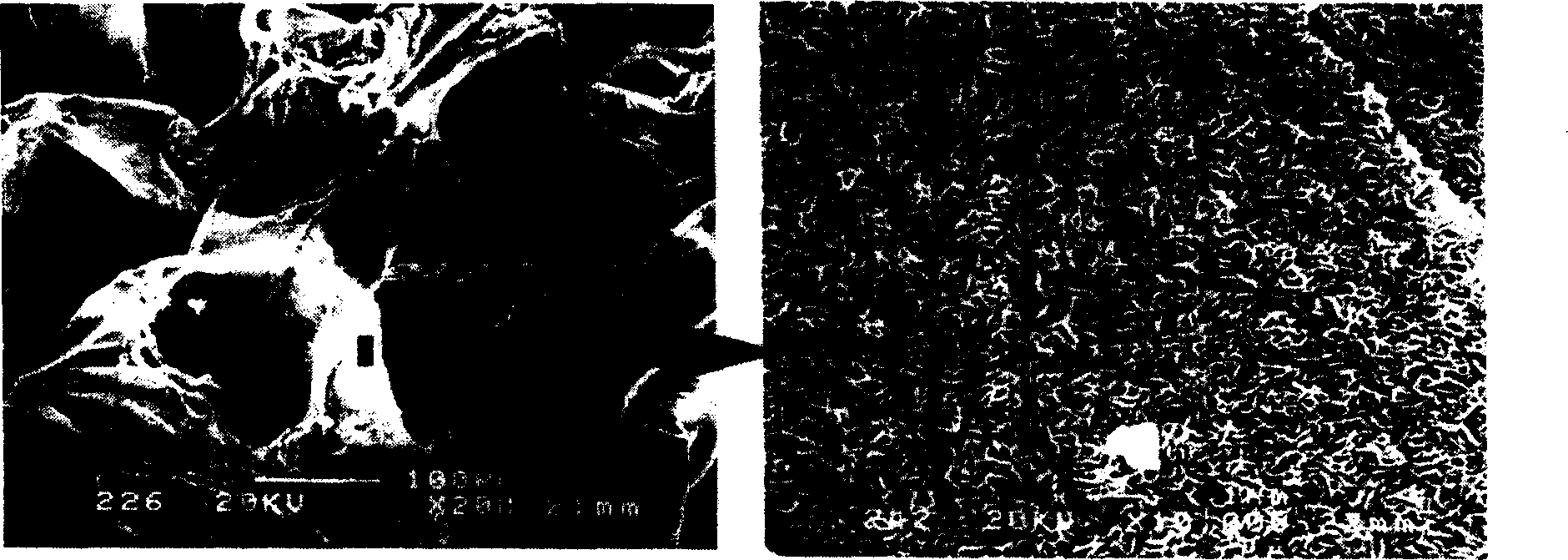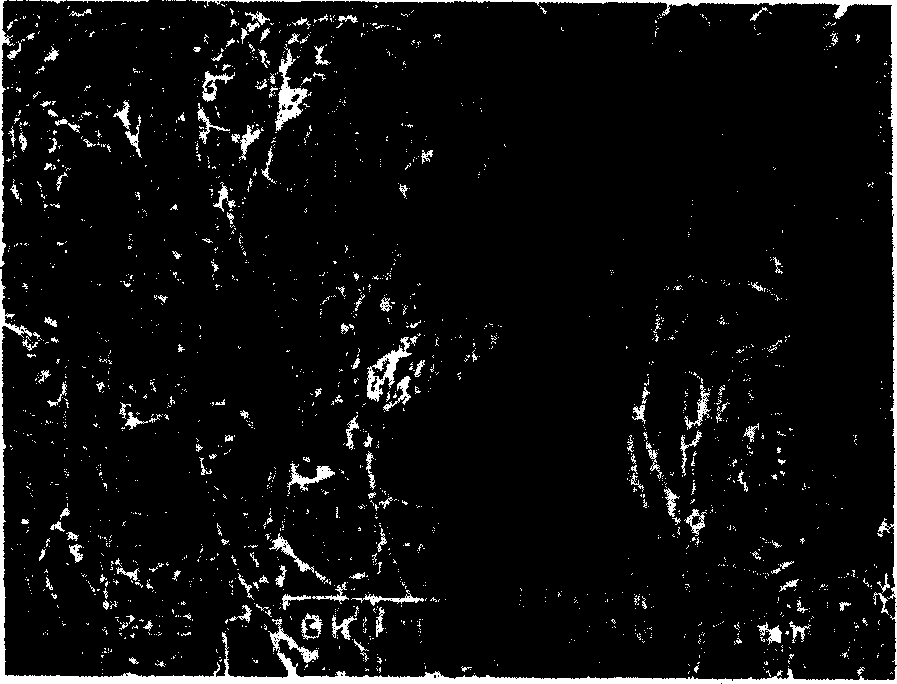Three-dimensional porous tissue engineering stand material and preparation thereof
A tissue engineering scaffold and three-dimensional porous technology, applied in the field of biomedical materials-tissue engineering scaffold materials, can solve the problems of natural polymers lacking spatial structure and mechanical strength, and unsatisfactory biodegradability, etc., to achieve good biological activity and degradation Sexuality, low cost, and wide-ranging effects
- Summary
- Abstract
- Description
- Claims
- Application Information
AI Technical Summary
Problems solved by technology
Method used
Image
Examples
Embodiment 1
[0043] With 1M acetic acid solution preparation concentration is that the gelatin solution of 15% and the chitosan solution that concentration is 1%, then by 1: 1 it is uniformly blended, and obtaining gelatin, chitosan content are respectively (by mass) 7.5%, 0.5% gelatin / chitosan mixed solution. Add GPSM and calcium nitrate to the above solution respectively, wherein GPSM / calcium nitrate is (by mass) 1 / 0.05; GPSM / (gelatin+chitosan) is (by mass) 0.5 / 1. The above solution was fully mixed for 4 hours at 40°C until it was completely uniform (no phase separation), and then 25ml of it was injected into a 5cm×8cm mold, sealed, and placed in a thermostat at 40°C for 3 days to obtain gelatin-chitopolymer Sugar-calcium silicate gel. Add 10 ml of 1M ammonia solution to the above-mentioned mold, let it stand at 25° C. for 16 hours, and then fully wash it with 1M NaCl solution and distilled water until neutral. Pre-freeze the ammonia-treated gel at -20°C for 24 hours, and then freeze-d...
Embodiment 2
[0047] Use 0.1M hydrochloric acid solution to prepare a gelatin solution with a concentration of 10%, add GPSM and calcium nitrate to the above solution respectively, wherein GPSM / calcium nitrate is (by quality) 1 / 0.05; GPSM / gelatin is (by quality) 0.5 / 1 . The above solution was fully mixed at 40°C for 4 hours until it was completely uniform (no phase separation), and then 25ml of it was injected into a 5cm×8cm mold, sealed, and placed in a thermostat at 40°C for 3 days to obtain gelatin-silicic acid calcium gel. Add 10 ml of 1M ammonia solution to the above-mentioned mold, let it stand at 25° C. for 16 hours, and then fully wash it with 1M NaCl solution and distilled water until neutral. The ammonia-treated gel was pre-frozen at -20°C for 24 hours, and then freeze-dried at -40°C at 5KPa for more than 48 hours. After freeze-drying, a gelatin-calcium silicate three-dimensional porous scaffold could be obtained. The porosity of the obtained porous material was tested by the Ar...
Embodiment 3
[0049] With 1M acetic acid solution preparation concentration is that the gelatin solution of 15% and the chitosan solution that concentration is 1%, then by 1: 1 it is uniformly blended, and obtaining gelatin, chitosan content are respectively (by mass) 7.5%, 0.5% gelatin / chitosan mixed solution. Add GPSM and calcium nitrate to the above solution respectively, wherein GPSM / calcium nitrate is (by mass) 1 / 0.05; GPSM / (gelatin+chitosan) is (by mass) 0.5 / 1. The above solution was fully mixed for 4 hours at 40°C until it was completely uniform (no phase separation), and then 25ml of it was injected into a 5cm×8cm mold, sealed, and placed in a thermostat at 40°C for 3 days to obtain gelatin-chitopolymer Sugar-calcium silicate gel. Add 10 ml of 1M ammonia solution to the above-mentioned mold, let it stand at 25° C. for 16 hours, and then fully wash it with 1M NaCl solution and distilled water until neutral. Pre-freeze the ammonia-treated gel in liquid nitrogen (-196°C) for 2 hours,...
PUM
 Login to View More
Login to View More Abstract
Description
Claims
Application Information
 Login to View More
Login to View More - R&D
- Intellectual Property
- Life Sciences
- Materials
- Tech Scout
- Unparalleled Data Quality
- Higher Quality Content
- 60% Fewer Hallucinations
Browse by: Latest US Patents, China's latest patents, Technical Efficacy Thesaurus, Application Domain, Technology Topic, Popular Technical Reports.
© 2025 PatSnap. All rights reserved.Legal|Privacy policy|Modern Slavery Act Transparency Statement|Sitemap|About US| Contact US: help@patsnap.com



